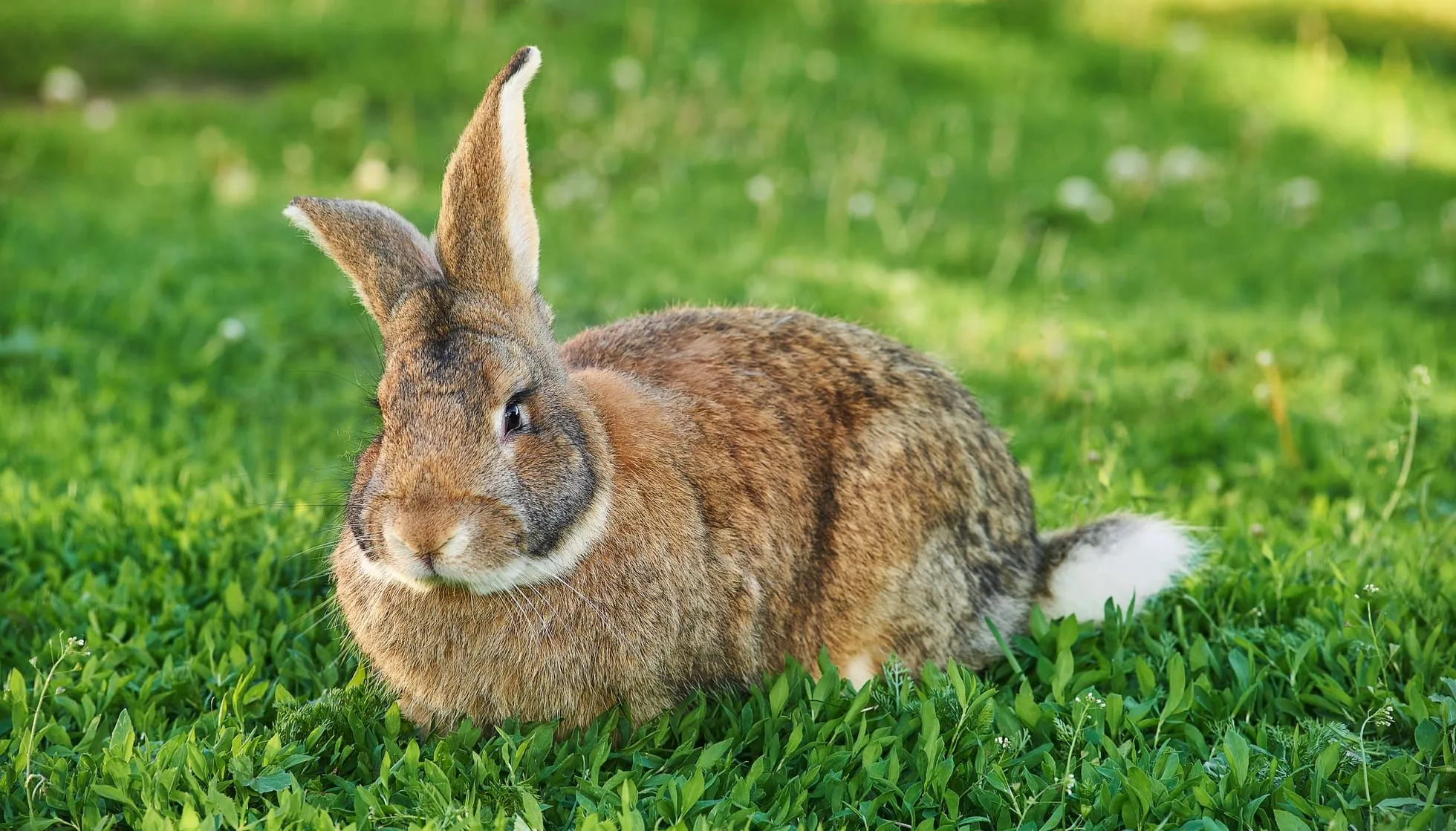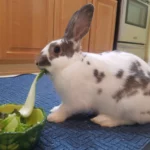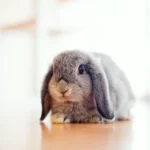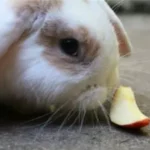Flemish giant rabbits are much bigger than your average-sized rabbit. They may look a bit strange at first glance.
Giant rabbits have the same basic needs as smaller rabbits.
Flemish Giant rabbits need more food, living space, and attention than regular-sized rabbits.
They may also need more veterinary care.
They are docile, intelligent, and friendly—as long as they are kept in the right conditions.
How to Care for a Flemish Giant Rabbit
If you plan to adopt a Flemish Giant, you should be aware of the following:
- Living Space Requirements – Standard rabbit hutches are not big enough for Flemish Giant rabbits. So consider Bigger living spaces for your giant rabbit.
- Food Requirements – Giant rabbits don’t have any unique dietary requirements. But they do eat a lot more food than standard-sized rabbits.
- Grooming – Although they are not long-haired, Flemish Giants need to be groomed weekly.
- Handling a Flemish Giant – Most rabbits hate being handled, but this is especially true with giants. You will need to know how to handle a giant rabbit safely.
- Preventing Disease – Some illnesses and diseases are more prevalent in giant breeds. We’ll show you how these diseases can be prevented.
As long as you have the right resources on hand, caring for a giant rabbit is not too difficult.
Characteristics of Flemish Giant Rabbit
- A broad body with a heavy bone structure
- Flemish Giants in the U.S. tend to have a semi-arched back, while Flemish rabbits in Britain tend to have a flatter back
- Thick and glossy fur (with a dense undercoat)
- Males have larger heads and females have a dewlap
- When you stroke the rabbit, there will be a roll-back effect with the fur
- Long ears
- Bold, endearing eyes
- Seven different colors – Black, blue, Fawn, Light Gray, Steel Gray, White, and Sandy
- A lifespan of 4-6 years – some Flemish Giants have lived beyond 8 years, but this is rare.
The personality of Flemish Giant Rabbit
Giants from Flanders have very unique personalities. They are smart, easy to get along with, and friendly.
Flemish Giants are loyal and usually have a favorite human. If you are picked, you are lucky, because these rabbits are a lot of fun to be around.
Even though Flemish Giants are very friendly, they can hurt you if they feel suddenly threatened.
Giant rabbits don’t like being touched, and if they are handled wrong, they will often thrash their feet or bite.
Flemish Giants may also bite if they are stroked for too long or feel like they can’t get away. They can also talk a lot when they are upset or stressed.
Young children should also learn how to handle one so they don’t get hurt.
How Big Do Flemish Rabbits Get?
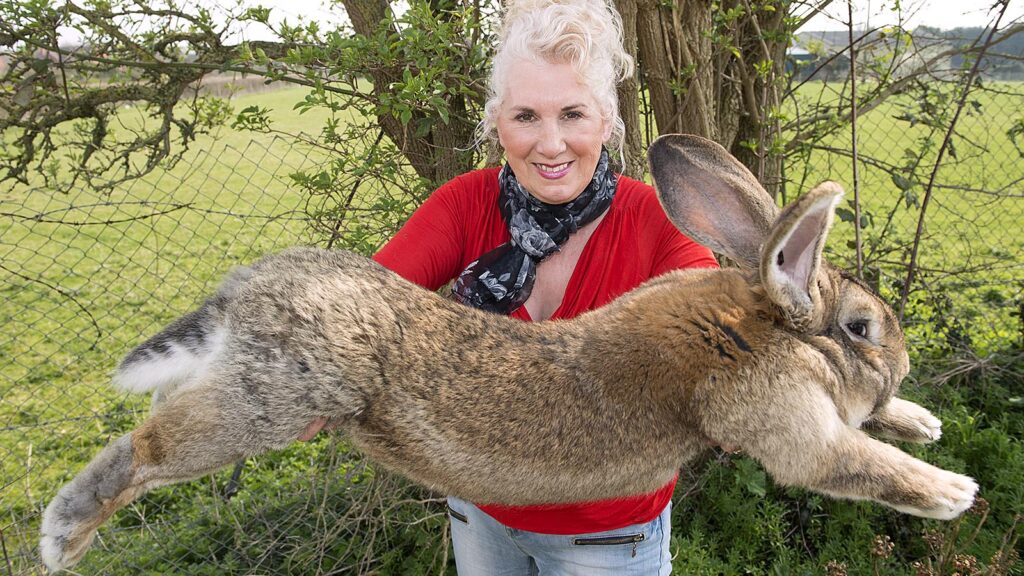
The longest Flemish Giant rabbit, according to the Guinness World Records, was 4 feet, 3 inches (1.3 meters) long.
But this is pretty strange. Most Flemish are between 2.5 and 3 feet long (76cm – 91cm). Still, this is longer than a lot of dogs.
What is the Average Weight of a Flemish Giant Rabbit?
PDSA says that a typical Flemish Giant weighs about 7 kg (15 lbs.). That’s the same as the weight of three Chihuahuas. Most men are heavier than most women.
Show-worthy Flemish About 10 kg is the weight of a giant rabbit (22 lbs.). That weighs the same as two gallons of paint.
Giant Rabbit Comparison
Giant rabbits don’t just come in the form of Flemish rabbits. At least 6 types of giant rabbits exist.
See how big Flemish Giants are compared to other big rabbits in the table below.
| Giant Rabbit Breed | Average Weight in kg | Average Weight in Lbs. |
|---|---|---|
| Belgian Hare | 2.7 – 4.5 | 6 –10 |
| New Zealand White | 4 – 5 | 9 – 12 |
| French Lop | 4.5 – 6.8 | 10 – 15 |
| English Lop | 5.5 – 6.8 | 12 – 15 |
| Flemish Giant | 6.5 – 7 | 15 |
| Continental Giant | 7 – 8 | 15 – 17 |
To give you an idea of how big this is, the average weight of a pet rabbit is 1 kg. So, a Flemish Giant is about six times as big as a typical rabbit.
How Much Space do Flemish Giant Rabbits Need?
Flemish Giant rabbits need a lot of room to move around, so a regular rabbit hutch won’t do. And, like all rabbits, Flemish Giants need a bonding partner, so ideally you should have room for two rabbits.
your rabbit should be able to jump at least three times in a row inside its enclosure. To get a rough idea of how much space you need, multiply the length of your rabbit’s body by 4.
So, a Flemish Giant that is 2.5 feet long will need a pen that is at least 10 feet long.
Also, rabbits should be able to stretch out across their cage and sleep comfortably. If your rabbit is 2.5 feet long, you should try to make it 4 feet wide.
Also, Flemish Giants often stand on their hind legs, so the enclosure needs to be at least as tall as your rabbit when it is stretched out (plus a bit more). So, the average Giant Flemish would need a cage that is at least 4 feet high.
Keeping this in mind, the minimum size of the enclosure would be 10 feet by 4 feet by 4 feet (3 x 1.2 x 1.2 m).
Even so, this size of the enclosure is the bare minimum. If you can, give your rabbit more space then give them as much as you can.
Flemish Rabbit Living Requirements
The length of the average rabbit hutch is close to 10 feet. So, if you want to give a house to your giant rabbit, you’ll have to think outside the box.
You can take care of giant rabbits in the following ways:
- A Shed That Has Been Changed: Most medium-sized sheds are big enough to fit two giant rabbits. You’ll have to make sure that the shed is safe. If possible, you should attach a run to the shed so that your rabbits can run around the garden.
- An aviary – Giant rabbits do well in big cages for birds. If you keep your rabbits outside in this type of enclosure, you will need to build good fencing to keep predators away.
- Dog Cages: Giant rabbits can live in bigger dog cages. Giant rabbits can easily get sore hocks, so it’s important to cover the wire floor with a firm mat and soft bedding.
- A Room Inside: Most of the time, it’s best to keep a giant rabbit in one room in the house. Make sure there are no wires in the room and that you can’t get to the rest of the house.
Rabbits pairs should live in rooms, sheds, or aviaries instead of cages. This is because they have enough room for the rabbits to get along with each other and spend time alone when they need to.
Indoors vs Outdoors
Giants from Flanders can live inside or outside. If you keep them inside, make sure the temperature doesn’t go above 90°F.
Also, don’t keep them in places that are too humid. Some people keep rabbits in their laundry rooms, which is a bad idea because this is a very humid part of the house.
If you keep your rabbits outside, make sure that no animals that could hurt them can get into your garden.
Also, don’t put the rabbits in a very public place. If your neighbors can look into your garden, the rabbits might be scared away.
Bedding Requirements
Because they are so big, giants often have sore hocks. This means that giant rabbits can’t live on wire floors.
If you want to reuse a dog cage or another type of cage with a wire floor, you should put resting pads and bedding on the floor.
So, what is the best place for giant rabbits to sleep? Well, one of the things rabbits like to sleep on is hay. A warm hay bed will be perfect for your rabbit.
If your rabbit lives inside, you might not want to give it hay because it will make a mess.
In this case, you could use blankets or carpet as the main type of bedding and only put hay in a small corner of the room.
Hay can be put on a rubber mat to keep it from getting on the carpet or floor.
Litter Tray Bedding for Flemish Rabbits
Flemish Giants are usually very easy to train to use the litter box because they are very friendly. But if you want to train your rabbits to use the litter box, you need to choose the right litter.
You shouldn’t use crystal litter because it can cut the feet of rabbits. These are the best kinds of litter:
- Paper-based Pellets – These are great for absorbing odor.
- Hardwood Stove Pellets – These are an affordable and absorbent option.
Cleaning up
Like any other kind of rabbit, Flemish Giants need to be cleaned. Rabbit poop and urine will be one of the hardest things to clean up.
If you’ve only had small rabbits before, you’ll notice that Flemish rabbit poop is a lot bigger.
When first-time owners see this, it can make them nervous, but it’s normal.
Make sure you always clean the litter box every day and clean the cage often.
How to Groom Flemish Rabbit?
Flemish giants don’t need a lot of grooming, but they will need a little help every now and then.
Set aside 20 – 30 minutes per week to groom your rabbit.
The fur on a Flemish Giant is very thick. When too much fur is eaten, it can cause or make a condition called GI stasis worse. This is very bad and should be stopped as soon as possible.
Flemish rabbits like being gently brushed, if nothing else. So, grooming can also be a way to spend time together.
It’s important to use the right tools and be gentle when you groom your rabbit. These are the most useful tools:
- A Soft Brush—When a rabbit is brushed with a soft brush, it feels good and calms down. Most of the time, it is strong enough to pull out loose fur and see how your rabbit’s fur looks.
- Rubber Brushes: During the malting season, rubber brushes are the best way to get rid of hair. In the spring and fall, rabbits lose their fur.
- A Slicker Brush: This is great for removing tangles and getting to the thick undercoat, but it needs to be used carefully.
- Flea Comb: This can get rid of fleas, flea eggs, and dirt that won’t come off a rabbit’s fur. Again, it needs to be used with care.
What to Feed a Flemish Giant Rabbit?
Flemish Giants don’t need any special vitamins and minerals in the food they eat. They eat the same things that regular rabbits do, but they eat a lot more.
Water and grass hay must always be available for all rabbits. Keep in mind that giant rabbits will eat much more hay than small rabbits, so you’ll need to plan for this.
A normal-sized rabbit would eat one to two handfuls of greens every day, but a Flemish Giant will eat three to five handfuls.
RSPCA says that the average rabbit eats between 25 and 50 grams (1-2 egg cups) of high-fiber pellets every day.
A giant rabbit, on the other hand, can eat 5–7 egg cups every day. This should be closely watched, and if the rabbit gains too much weight, it should be cut back.
Unlike other rabbits, Flemish Giants don’t reach adulthood until they are 1.5 years old. So, some vets say that they should be fed more than 5-7 egg cups of pellets until they reach adulthood.
On the other hand, some vets say this isn’t necessary because it could cause the animal to become overweight.
Talk to a vet who knows about rabbits if you want to know how to feed young rabbits.
How to Entertain a Flemish Giant Rabbit?
The giant rabbits in Flanders are smart. If you want to keep one as a pet, you’ll need to give it a lot of different things to do.
Providing a large enclosure is one of the kindest ways to do this. This will give your rabbit enough room to act as a rabbit should.
Try the following, as well:
- Flemish Giants are like most rabbits in that they love tunnels. It might be hard to find the right tunnel, but there are some options.
- Try to get a run for your rabbit so it can go outside. Your bunny will be grateful. If you live in a place like Australia where Myxomatosis and mosquitos are common, you might want to put a mosquito net over the run.
- Change up your rabbit’s food every now and then. Don’t feed your bunny anything poisonous. Rabbits like Brussels sprouts and apple slices (without the seeds).
- Some rabbits like hunting for food, so you can ‘hide’ it to make them hunt for food. This reduces boredom.
- Even Flemish Giants need at least one friend who is also a rabbit. If you don’t give your rabbit a friend, it might get lonely and stressed out.
- Flemish rabbits like human interaction if you handled them as kittens. Interact with your rabbit twice a day. Instead of trying to pick up your rabbit, it’s best to get down on its level.
Common Diseases in Flemish Giant Rabbits
Research shows that the following health problems can happen to Flemish Giant rabbits:
- Sore Hocks (Pododermatitis): Because these rabbits are so heavy, their weight can press on their feet and cause sore hocks. This is usually only a problem if their enclosure has a wire mesh floor.
- Arthritis and Spondylosis: As your rabbit ages, keep an eye on how it moves. If they can’t take care of themselves, they may need medication.
- Rabbit Snuffles (P. Multocida): Rabbit snuffles are caused by the bacteria Multocida. Sage Pub says that P. multocida has a stronger effect on Flemish Giants than on New Zealand Giants. This suggests that Flemish Giants may be more likely to get rabbit snuffles than other giants.
- Heart problems like cardiomyopathy: It’s important to keep an eye on your rabbit’s breathing, especially as it gets older.
- Obesity: Giant rabbits are more likely than regular-sized rabbits to be overweight. This could be because some owners don’t realize how much space giant rabbits need to run around.
How Much Does a Flemish Giant Cost?
Flemish Giants cost between $30 and $60. If you want a Flemish that is especially big or good for shows, it will cost between $250 and $300.
It’s also important to think about how much these rabbits will cost you in the long run. On average, having a rabbit costs between $600 and $1200 per year. Most likely, a giant rabbit costs around $1200.
Where You Can Get a Flemish Rabbit?
The National Federation of Flemish Giant Rabbit Breeders is a good place to start if you want to buy a Flemish Giant Rabbit.
On the website of the NFFGRB, you can find a list of breeders who have been approved.
If you do a search on Google, you can also find local breeders in your area. Before you buy, check reviews and testimonials and look at the breeder’s credentials.
Common Questions to Ask:
- Is this rabbit pure Flemish?
- What personality traits does the rabbit have?
- How big are the mum and dad? Can I see them?
- Are there any health problems or genetic defects I should be aware of?
- How old is this rabbit? Usually, kittens should not leave their mothers until they are at least 8 weeks. In the case of Giant Flemish rabbits, kittens should be left with their mother for a slightly longer period (at least 10 weeks). This is because giant rabbits take longer to reach maturity.
Is the Flemish Giant Right for you?
Flemish giants are friendly, easy to get along with, and smart. They are great pets in a lot of ways.
But it’s a big deal to take care of a giant rabbit. Before you decide to adopt a Flemish Giant, think about the following:
- Do you have room for a 10x4x4-foot pen or a spare room in the house?
- Can you get your rabbit a lot of hay, pellets, and green vegetables?
- Do you have time at least once a week to groom your rabbit?
- Are you ready to pay the vet bills that come with having a rabbit?
- Can you take care of your rabbit every day?
- Is a big bunny a good fit for your family? Giant bunnies are good pets for older children, but they might not be good for families with very young children. This is because noise and heavy handling can make them very stressed.
If you answered “yes” to all of these questions, a Flemish Giant might be a good pet for you.
If you can’t find room for such a big rabbit, you could get a Belgian Hare or a New Zealand White rabbit instead.
